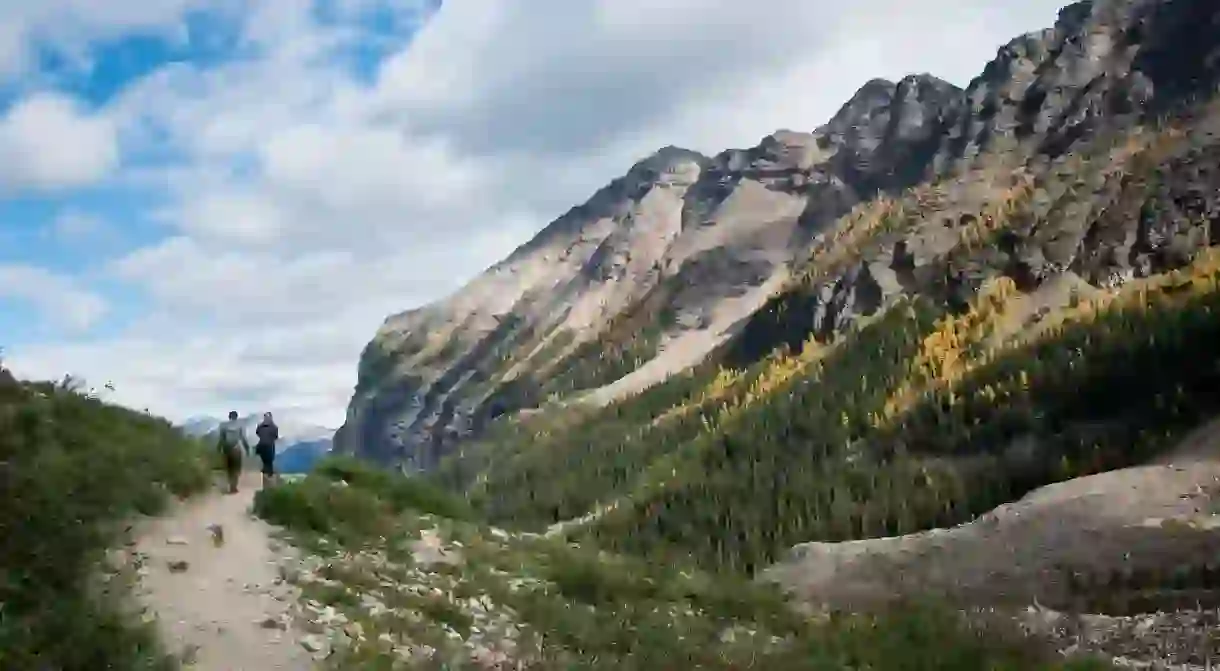The Best Hiking Trails in Banff, Canada

In Canada‘s Rocky Mountains and Alberta National Park, Banff is all about walking, hiking, biking, skiing and climbing. From the town of Banff itself to isolated corners of the national park, there are hundreds of trails worth exploring. Here’s our round-up of the best.
Banff is home to a great variety of wildlife, therefore it is important to walk with bear spray, never litter and respect closures. In the spring, be aware of the presence of ticks, and remember that dogs must be kept on leash. Hikers are asked to not take shortcuts on popular and well-defined trails, in order to reduce erosion. If you are planning a multi-day camping trip, make sure to visit Parks Canada online or the Visitor’s Center in town. Campsites fill up quickly.
Tunnel Mountain / Sleeping Buffalo
Natural Feature

The smallest of all the distinct mountains in Banff, Tunnel Mountain has no tunnel. In fact, there is a move afoot to change the name back to its Stoney First Nation name: Sacred Buffalo Guardian. The mountain is often referred to locally as Sleeping Buffalo. The mountain frames the town, and the trail up is easy to find from the center of Banff. Locals jog to the top in under 30 minutes, but count on an hour for your first ascent with the elevation factored in. The summit offers views over the town of Banff and the Bow River Valley.
Hiking around Lake Louise
Natural Feature, Park
Sulphur Mountain
Hiking Trail, Natural Feature

This popular mountain hike is the Banff’s only climb that offers a ride down. Starting from the Upper Hot Spring parking lot, the 5.5km (3.4mi) trail follows a series of switchbacks to the summit ridge and the upper terminal of the Sulphur Mountain Gondola. The trail is well maintained and achieves a 655m (2,100ft) elevation gain. Allow 2-3 hours. It is perfectly safe to walk down, and the trail is open year round.
Johnston Canyon Lower and Upper Falls
Natural Feature
Located on the original 1A highway halfway between Banff and Lake Louise, Johnston Canyon is no longer a local secret, and this popular walk is always beautiful, with the path suspended out into the canyon in certain sections. The Lower Falls can be reached in about 30 minutes, while the Upper Falls are another half hour with more elevation gain. This is a one-way, in-and-out hike – ice cleats are essential in the winter.
Lake Minnewanka and Aylmer Pass
Natural Feature
The second largest lake in Banff National Park, Minnewanka is close to town with public transport access. The obvious trail from the parking area along the north side of the lake is very popular, but can be long enough to escape the crowds, continuing for more than 18km (11mi). This is an accessible trail for overnight back country trip. Aylmer Pass Junction Campground has bear bins for food as well as tent sites and outhouses.
Sunshine Meadows
Resort

Banff Sunshine Village is one of the three ski resorts within Alberta National Park and is only 20 minutes west of town. The resort enjoys significant snowfalls and a long ski season. Snow enthusiasts with touring gear will skip the lift lines (and the ticket costs) and hike up the 5km (3mi) ski-out run to the village area. During the summer months, the meadows erupt with wildflowers. Healy Pass is another popular, longer hike that begins from the same location. Lift tickets can be purchased for the resort gondola and chairlifts when operating. Organized hikes are also available.
Mount Temple
Natural Feature
This challenging scramble is only recommended for experienced hikers. Mount Temple is the highest peak in the Lake Louise area and is capped with a dramatic hanging glacier. The route is over 15km (9mi) out and back with an impressive 1,700m (5,500ft) rise in elevation. The route is generally accessible between July and September.
Bow Summit Lookout
Natural Feature














